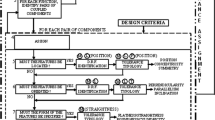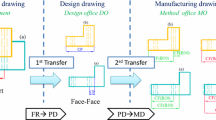Abstract
In conventional design, tolerancing is divided into two separated sequential stages, i.e., product tolerancing and process tolerancing. In product tolerancing stage, the assembly functional tolerances are allocated to BP component tolerances. In the process tolerancing stage, the obtained BP tolerances are further allocated to the process tolerances in terms of the given process planning. As a result, tolerance design often results in conflict and redesign. An optimal design methodology for both dimensional and geometrical tolerances (DGTs) is presented and validated in a concurrent design environment. We directly allocate the required functional assembly DGTs to the pertinent process DGTs by using the given process planning of the related components. Geometrical tolerances are treated as the equivalent bilateral dimensional tolerances or the additional tolerance constraints according to their functional roles and engineering semantics in manufacturing. When the process sequences of the related components have been determined in the assembly structure design stage, we formulate the concurrent tolerance chains to express the relations between the assembly DGTs and the related component process DGTs by using the integrated tolerance charts. Concurrent tolerancing which simultaneously optimizes the process tolerance based on the constraints of concurrent DGTs and the process accuracy is implemented by a linear programming approach. In the optimization model the objective is to maximize the total weight process DGTs while weight factor is used to evaluate the different manufacturing costs between different means of manufacturing operations corresponding to the same tolerance value. Economical tolerance bounds of related operations are given as constraints. Finally, an example is included to demonstrate the proposed methodology.
Similar content being viewed by others
References
Ngoi BKA, Ong JM (1999a) Optimum tolerance allocation in assembly. Int J Adv Manuf Technol 15:660–665
Ngoi BKA, Ong JM (1999b) A complete tolerance charting system in assembly. Int J Prod Res 37:2477–2498
Ramani B, Cheraghi SH, Twomey JM (1998) CAD-based integrated tolerancing system. Int J Prod Res 36:2891–2910
Swift KG, Raines M, Booker JD (1999) Tolerance optimisation in assembly stacks based on capable design. Proc Inst Mech Engrs 213(Part B):677–693
Eary DF, Johnson GE (1962) Process engineering for manufacturing. Prentice-Hall, Engelwood Cliffs, NJ
Ngoi KBA (1992) Applying linear programming to tolerance chart balancing. Int J Adv Manuf Technol 7:187–192
Ji P (1993a) A linear programming model for tolerance assignment in a tolerance chart. Int J Prod Res 31:739–751
Ji P (1993b) A tree approach for tolerance charting. Int J Prod Res 31:1023–1033
Ngoi BKA, Ong CT (1993) A complete tolerance charting system. Int J Prod Res 31:453–469
Wei CC, Lee YC (1995) Determining the process tolerances based on the manufacturing process capability. Int J Adv Manuf Technol 10:416–421
Lee YC, Wei CC (1998) Process capability-based tolerance design to minimise manufacturing loss. Int J Adv Manuf Technol 14:33–37
Lee YH, Wei CC, Chang CL (1999) Fuzzy design of tolerances to maximise process capability. Int J Adv Manuf Technol 15:655–659
Ji P (1999) An algebraic approach for dimensional chain identification in process planning. Int J Prod Res 37:99–110
Chang CL, Wei CC, Chen CB (2000) Concurrent maximization of process tolerances using grey theory. Robotics and computer-integrated manufacturing 16:103–107
Huang MF, Gao YS (2002) A discrete optimal tolerancing approach based on the process capabilities. J Huazhong Univ Sci Technol 30(4):19–21
Huang M, Gao Y, Xu Z, Li Z (2002) Composite planar tolerance allocation with dimensional and geometric specifications. Int J Adv Manuf Technol 20:341–347
Zhang G (1996) Simultaneous tolerancing for design and manufacturing. Int J Prod Res 34:3361–3382
Huang MF, Xu ZG, Gao YS, Li Z (2001) Optimal assembly tolerance allocation using hierachical hypergraphs. 17th International Conference on Computer-aided Production Engineering (CAPE 2001). Professional Engineering Publishing Limited London and Bury St Edmunds, UK, pp 411–414
Huang MF, Gao YS (2003) Optimal concurrent tolerancing based on sequential process capabilities. China Mechanical Engineering 14:385–389
Ngoi BKA, Ong CT (1997) A tolerancing optimisation method for product design. Int J Adv Manuf Technol 13:290–299
Gao Y, Huang M (2003) Optimal process tolerance balancing based on process capabilities. Int J Adv Manuf Technol 21:501–507
Chen YB, Huang MF, Yao JC, Zhong YF (2003) Optimal concurrent tolerance based on the grey optimal approach. Int J Adv Manuf Technol 22:112–117
He JR, Gibson PR (1992) Computer-aided geometrical dimensioning and tolerancing for process-operation planning and quality control. Int J Adv Manuf Technol 7:11–20
Ngoi KBA, Tan CK (1995) Geometrics in computer-aided tolerancing charting. Int J Prod Res 33:835–868
Ngoi BKA, Soew MS (1996) Tolerancing control for dimensional and geometrical specifications. Int J Adv Manuf Technol 11:34–42
Ngoi BKA, Agarwal M, Chua CS (1998a) The generic capsule approach to tolerance stack analysis. Int J Prod Res 36:3273–3293
Ngoi BKA, Agrwal M, Chua CS (1998b) The noded graph approach to stack analysis. Int J Adv Manuf Technol 14:343–349
Ngoi BKA, Lim LEN, Ang PS, Ong AS (1999a) Assembly tolerance stack analysis for geometric characteristics in form control-the “Catena” method. Int J Adv Manuf Technol 15:292–298
Ngoi BKA, Lim LEN, Ong AS, Lim BH (1999b) Applying the coordinate tolerance system to tolerance stack involving position tolerance. Int J Adv Manuf Technol 15:404–408
Ngoi BKA, Lim BH, Ang PS (2000a) Nexus method for stack analysis of geometric dimensions and tolerancing (GDT) problems. Int J Prod Res 38:21–37
Ngoi BKA, Lim BH, Ong AS (2000b) The Nexus method for evaluating geometric dimensioning and tolerancing problems with position callout. Proc Instn Mech Engrs 214(Part B):235–241
Tseng YJ, Kung HW (1999) Evaluation of alternative tolerance allocation for multiple machining sequences with geometric tolerances. Int J Prod Res 37:3883–3900
Author information
Authors and Affiliations
Corresponding author
Rights and permissions
About this article
Cite this article
Huang, M., Zhong, Y. Dimensional and geometrical tolerance balancing in concurrent design. Int J Adv Manuf Technol 35, 723–735 (2008). https://doi.org/10.1007/s00170-006-0749-2
Received:
Accepted:
Published:
Issue Date:
DOI: https://doi.org/10.1007/s00170-006-0749-2




